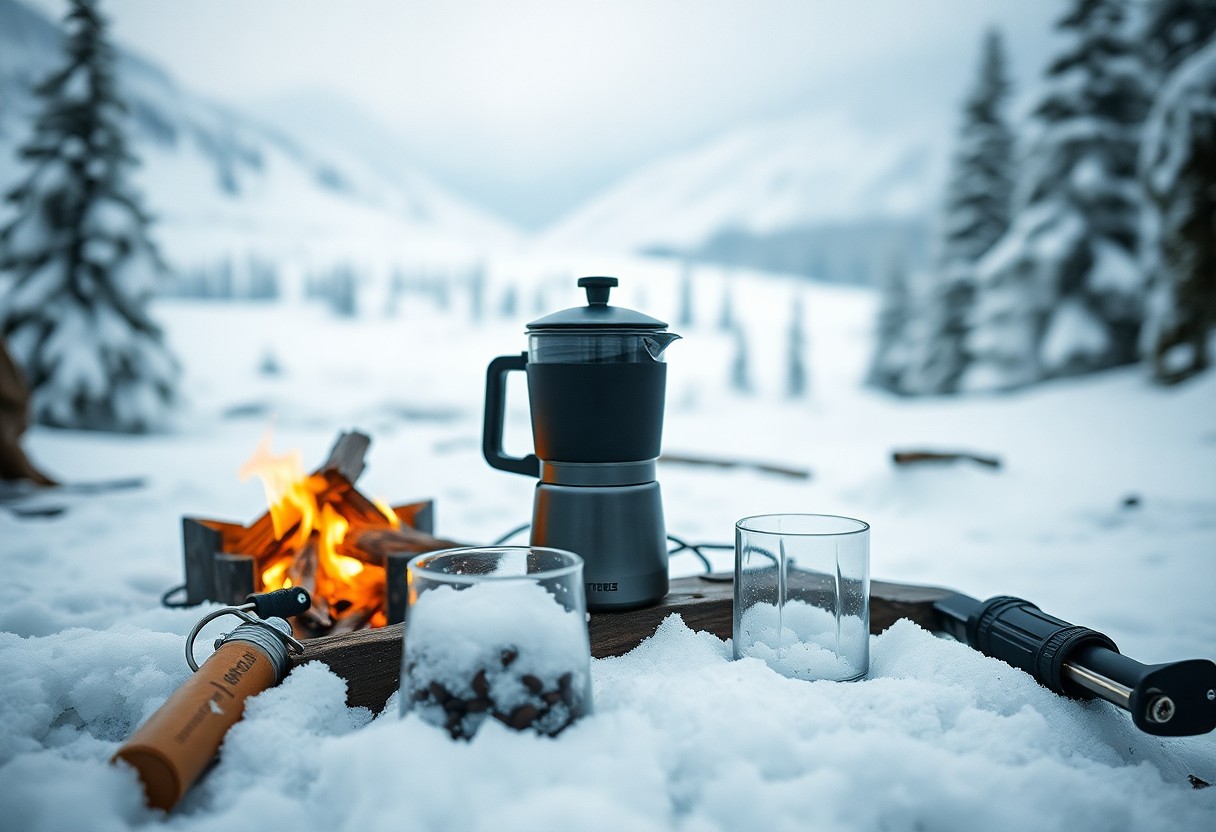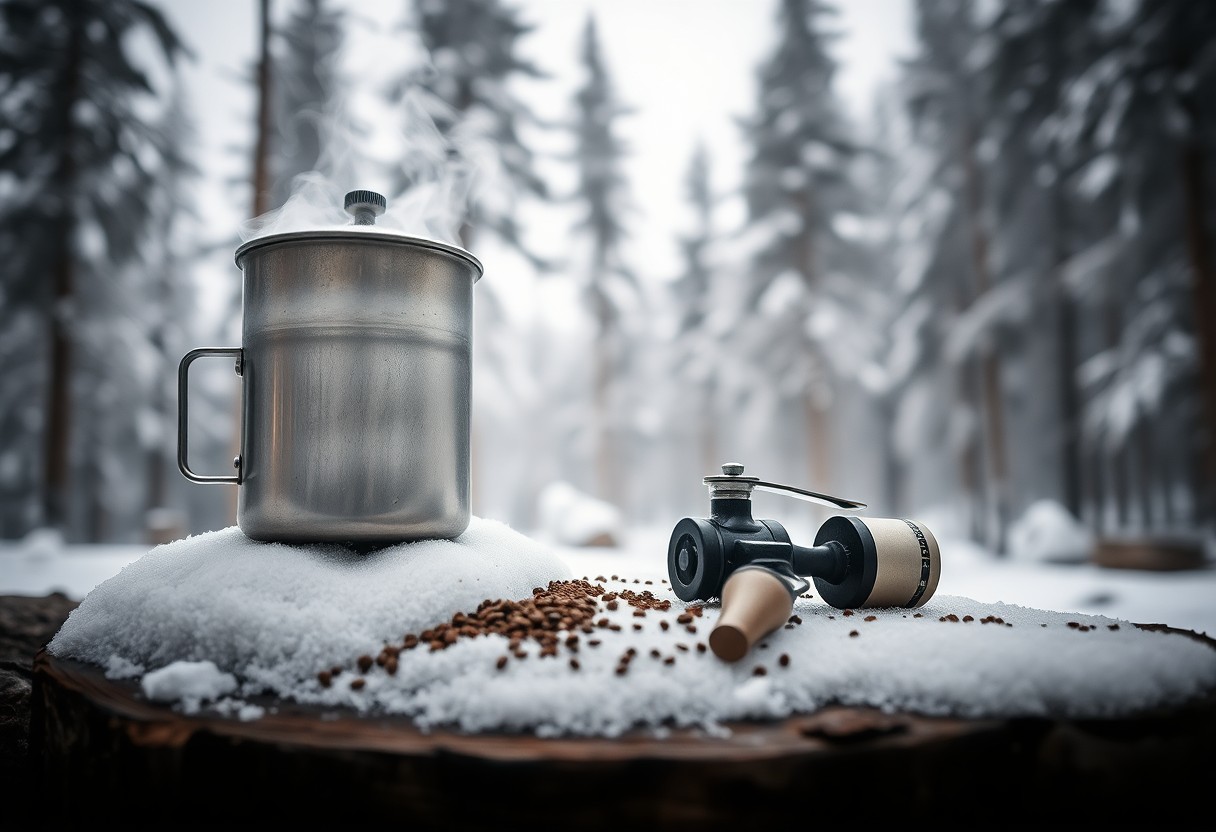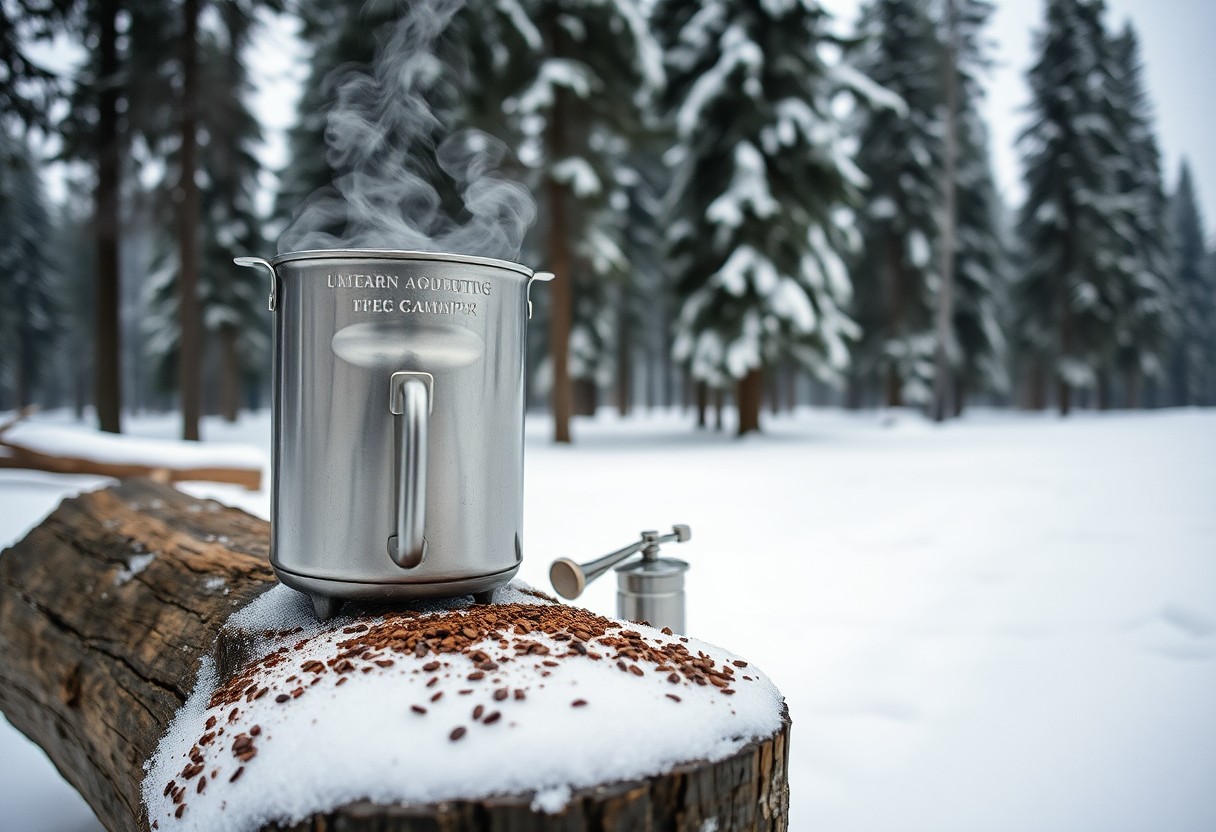There’s a unique way to elevate your coffee experience while harnessing the beauty of nature: brewing coffee with melted snow. This method not only provides you with pure, clean water but also connects you more deeply to your surroundings. When you understand how to safely collect and melt snow, you’ll discover how this process adds a distinct flavor profile to your brew. Plus, it’s an excellent survival skill for outdoor enthusiasts who prioritize taste in their adventures. Get ready to enrich your coffee ritual in an entirely new way!
Key Takeaways:
- Melted snow can provide a unique and refreshing water source for brewing coffee, emphasizing the importance of utilizing available resources in a survival situation.
- The temperature of the melted snow should be adequate when combined with coffee grounds to achieve optimal flavor extraction, enhancing the overall tasting experience.
- Experimenting with different brewing methods while using melted snow can elevate the flavor notes of the coffee, making it enjoyable and invigorating even in challenging circumstances.

The Allure of Snow-Crafted Brews
The act of brewing coffee with melted snow goes beyond mere survival—it evokes a deep connection to nature. Each sip carries the essence of the great outdoors, offering an experience that no bottled water or tap supply can match. By sourcing your brewing water from pristine snow, you infuse your coffee with the purity of an untouched landscape, capturing a fleeting moment when winter’s beauty becomes a delightful, warm beverage. It’s not just about survival skills; it transforms your coffee ritual into a celebration of your surroundings.
The Romanticism of Nature’s Ingredients
Using snow as a brewing ingredient adds a layer of romanticism to your coffee experience. The snowy landscape paints a picturesque backdrop for your culinary adventure, providing a sensory delight that awakens your connection to the elements. This intimate interaction makes the simple act of brewing coffee feel like a celebration of nature’s beauty, turning your daily routine into a mindful moment rich with significance.
Historical Precedents for Snow Utilization in Cooking
Throughout history, cultures have utilized snow for various culinary applications, showcasing its versatility and charm. During the winter months, people in regions like Japan and parts of Scandinavia would gather snow for cooling drinks and preserving food. Its unique properties helped to create delicacies like ‘shaved ice’ desserts, illustrating a long-standing appreciation for the frozen form in culinary traditions. This historical context elevates your snow-crafted coffee, linking it to a broader narrative of resourcefulness and creativity.
In Japan, traditional practices included using snow to chill food and beverages, demonstrating how snow was embraced as a culinary asset. Scandivian communities would add snow to soups and broths, leveraging its cold to adjust temperatures during cooking. These historical applications highlight a time-honored recognition of snow’s utility, and by incorporating such a timeless practice into your modern coffee ritual, you become part of a lineage that celebrates resourcefulness and connects you to previous generations who saw the beauty in every drop of melted snow.
Essential Techniques for Harvesting Snow
Harvesting snow for brewing coffee requires a few necessary techniques to ensure a clean and flavorful end result. First, consider the location where you collect your snow. Look for areas away from roads, industrial sites, or any other pollution sources. Light, fluffy snow that falls during dry conditions offers the best quality, whereas settled, compact snow may introduce unwanted impurities. Use a clean container for collection, and avoid touching the snow with your hands to maintain its purity. These practices set the stage for a truly unique brewing experience.
Choosing the Right Type of Snow for Brewing
Opt for freshly fallen snow that is light and airy, as it has a higher purity level compared to older, compacted snow. Fluffy, powdery flakes typically indicate low moisture content and fewer contaminants, making it the ideal choice for brewing. Avoid snow that appears yellow or discolored, as this can signify the presence of dirt or pollutants. Your coffee’s flavor will undoubtedly benefit from the right type of snow, ensuring a refreshing and crisp brew.
Safe Collection Methods: Purity and Prevention
Ensuring the snow you harvest for brewing coffee is pure is vital for both taste and health. Begin by using a clean container, ideally made of food-grade materials like stainless steel or BPA-free plastic. Try to collect snow from elevated areas, like hillsides, rather than flat surfaces where debris can gather. Avoid gathering snow from near animal tracks or areas where animals frequent, as their presence could contaminate your supply. After collecting, seal your container to prevent any further contamination, and you’ll enjoy a fresh, worry-free brewing experience.
While collecting snow, scout for a clean, isolated area outdoors, far from urban pollution. Maintaining a natural buffer can be beneficial; collect from areas with little or no animal activity, maintaining an eye out for any visible debris within the snow. The use of a clean shovel or scoop rather than hands will minimize contamination and mixing with other particles. After collection, once you’ve sealed your container, store it in a cool, shaded spot to maintain the snow’s original texture and flavor until you’re ready to brew.
Artistic Methods to Maximize Flavor
Snow as Water: Temperature and Brewing Considerations
Utilizing snow as your brewing water introduces a unique flavor profile that can be enhanced by understanding temperature dynamics. Snow, when melted, produces water that tends to cool faster than tap water due to its purity and low mineral content. To optimize your brew, it’s advisable to bring the melted snow to about 195°F to 205°F before brewing. This temperature range extracts flavors robustly from your coffee grounds without scalding them, allowing for a balanced and flavorful cup.
Water Temperature and Brewing Tips
| Consideration | Details |
|---|---|
| Water Temperature | Optimal brewing ranges from 195°F to 205°F. |
| Melted Snow Characteristics | Cooler than tap water, ensuring a rich extraction. |
| Brewing Time | Adjust to maintain extraction balance due to temperature. |
Complementary Ingredients: Enhancing the Experience
Elevating your snow-brewed coffee can be achieved by incorporating complementary ingredients. Fresh herbs like mint or spices such as cinnamon can transform your cup into an aromatic experience, while a dash of sea salt brings out deeper flavors without masking them.
Enhancing your snow-brewed coffee can turn an ordinary drink into an extraordinary experience. Adding organic ingredients like vanilla beans, crushed peppercorns, or even a sprinkle of cocoa powder creates a complex flavor profile. Additionally, a touch of maple syrup or local honey adds sweetness without being overpowering. Such elements harmonize beautifully with the purity of melted snow, allowing you to explore flavors that are uniquely your own, elevating each sip to a delightful sensory adventure.
Survival Skills and Gourmet Moments
Making the most of survival situations doesn’t mean you need to sacrifice flavor. Your brewing method can become a gourmet experience even in the wild, where melted snow transforms your coffee ritual into a unique blend of necessity and indulgence. This not only awakens your senses but also elevates your spirit amid challenging circumstances. As you refine your technique, you’ll uncover new ways to savor a simple cup of coffee, proving that survival and gourmet experiences can coexist beautifully.
Flavor Profiles: The Unique Twist on Traditional Brewing
Melted snow brings an exciting freshness to your coffee, lending subtle complexities that enhance your brew. The purity of snowmelt water allows the natural flavors of your coffee beans to shine, creating a clean, bright cup. As you experiment with different roast levels, you may discover previously unnoticed notes such as floral, nutty, or fruity undertones that transform your daily brew into a unique tasting experience.
Survival Scenarios: When Gourmet Meets Necessity
In dire situations, having an exquisite cup of coffee can be more than just a luxury; it becomes a pillar of mental comfort. Imagine finding yourself in the wilderness after a long and grueling day. The warmth of a lovingly brewed coffee made from snowmelt not only rehydrates but also invigorates your spirits. You’re faced with challenges, but that small ritual of brewing your coffee elevates your morale and makes survival feel a bit more indulgent.
Survival may often invoke thoughts of bare importants, but it’s in moments when gourmet choices can provide solace. Creating a comforting cup using melted snow can invigorate your soul during tough circumstances. Picture yourself heating water on a makeshift fire, carefully combining grounds to produce an aromatic brew that transports you far from your current surroundings. Every sip can remind you that even in the most challenging situations, there’s room for enjoyment and a touch of luxury, reinforcing your resolve and lifting your spirits.

Brewing Coffee in the Wild: A Step-by-Step Guide
| Step | Description |
|---|---|
| 1. Collect Snow | Gather clean snow and pack it into your pot. Aim for about a cup of packed snow for a small brewing batch. |
| 2. Heat the Snow | Place the pot over your camping stove or fire, allowing the snow to melt gradually into water. |
| 3. Add Coffee | Once melted, measure in your preferred coffee grounds, typically one to two tablespoons per cup of water. |
| 4. Brew | Allow the mixture to come to a gentle boil, stirring occasionally, then remove from heat to steep for 3-5 minutes. |
| 5. Strain and Serve | Strain the coffee through a filter or a fine mesh to remove grounds before pouring into your mug. |
Essential Gear for the Adventure
A few crucial items elevate your snow-brewed coffee experience. A durable, lightweight camping pot is preferable to withstand direct heat. A reliable portable stove or fire solution provides the necessary heat source, while a coffee filter or fine mesh sieve helps in straining grounds. Don’t forget your favorite coffee, ideally ground for ease, and a collapsible mug for sipping your rejuvenating brew in the wilderness.
Recipe Variations: Tailoring to Taste Preferences
Customizing your wilderness coffee to suit your taste buds makes every outdoor moment unique. From flavored additives like cinnamon or cocoa to using milk or non-dairy creamer, you can significantly enhance your cup. Experimenting with the coffee-to-water ratio will also help craft a brew that satisfies your personal preference—strong or mild; it’s entirely up to you!
For those with a penchant for adventure, blending flavors can turn an ordinary cup into an extraordinary experience. A sprinkle of vanilla powder or a hint of nutmeg enriches the flavor profile while a bit of sugar or honey can sweeten your brew. Consider bringing along a small selection of your favorite spices or flavorings to turn your simple snow-brewed coffee into a gourmet treat that rivals any café experience.
Final Words
Ultimately, brewing coffee with melted snow can enhance your outdoor experience and provide a unique twist to your daily routine. As a flavor lover, you can enjoy the subtle differences in taste that snowmelt brings to your brew, while also honing your survival skills. By mastering this technique, you not only enjoy a delicious cup of coffee but also develop a deeper connection with nature. So, next time you’re in the wild, don’t hesitate to embrace this method and elevate your coffee game while enjoying the great outdoors.
FAQ
Q: Is it safe to use melted snow for brewing coffee?
A: Yes, melted snow can be safe for brewing coffee if it is collected from a clean, unpolluted area. Ensure that the snow is fresh and avoid gathering it near roads, industrial areas, or where animals frequent. It’s also recommended to filter the melted snow to remove any impurities before brewing your coffee.
Q: Does brewing coffee with melted snow affect the flavor?
A: Brewing coffee with melted snow can impart a unique flavor profile to your beverage. The snow may contain trace minerals and organic compounds, which could enhance the taste. However, the flavor will also depend on the quality of the coffee beans used and the brewing method. Experimenting with different bean varieties can yield interesting results!
Q: What equipment is best for brewing coffee in a survival situation using melted snow?
A: In a survival scenario, simple and portable gear is ideal. A compact camping coffee maker, French press, or even a pour-over cone can work well. If you don’t have any gadgets, you can boil water in a pot and steep coffee grounds directly in it. Just make sure to have a way to heat the snow until it becomes water first!
Q: How much melted snow do I need to brew a cup of coffee?
A: To brew a standard cup of coffee (about 8 ounces), you will need roughly 10-12 ounces of melted snow, as it takes some volume to account for evaporation or absorption by the coffee grounds. To ensure a proper brew, follow the specific coffee-to-water ratio recommended for your preferred coffee method, typically around 1 to 2 tablespoons of coffee for every 6 ounces of water.
Q: Can I use melted snow as my only water source for an extended period?
A: While melted snow can be a great temporary water source, relying on it exclusively for long periods isn’t advisable. Snow can be low in minerals and may not sufficiently hydrate you over time. It’s best to supplement melted snow with other water sources whenever possible, like rivers or streams, to maintain balanced hydration and nutrient intake.
